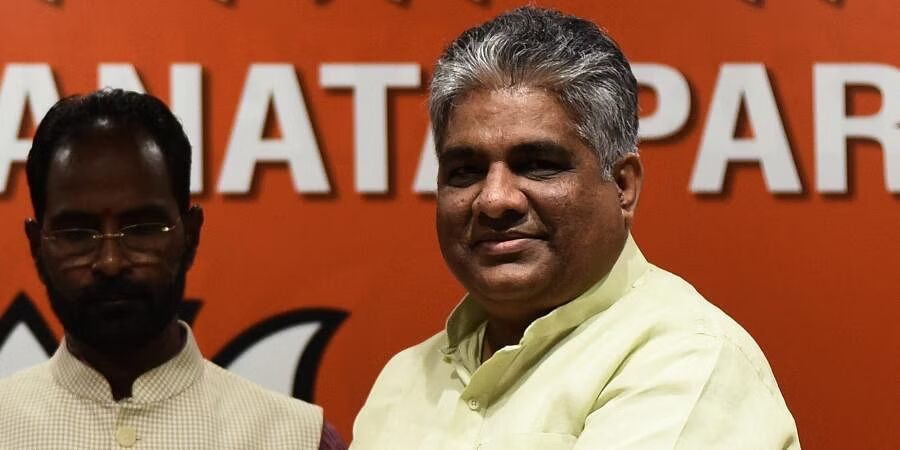19 pc rise in farm fires in Punjab; AAP turned Delhi into gas chamber: Bhupender Yadav

New Delhi: Union Environment Minister Bhupender Yadav launched a scathing attack on AAP on Wednesday, saying that there has been a 19 per cent rise in farm fires over 2021 in Punjab and the party has turned the national capital into a gas chamber.
He also said that Punjab Chief Minister Bhagwant Mann has failed to even provide relief to farmers in his own constituency, Sangrur, adding that last year during the period from September 15 to November 2 farm fires in Sangrur stood at 1,266. This year they have shot up by 139 per cent, rising to 3,025.
"Scam is where AAP is. In the last 5 years, the central Government gave Rs 1,347 crore for crop residue management machines to Punjab. The state bought 1,20,000 machines. 11,275 of those machines have gone missing. Money utilisation shows clear incompetence," Yadav said in a series of tweets.
He said as of today, Punjab, a state run by the AAP government, has seen an over 19 per cent rise in farm fires over 2021. BJP-ruled Haryana has seen a 30.6 per cent drop.
"Just today, Punjab saw 3,634 fires. There is no doubt over who has turned Delhi into a gas chamber," he said.
The Union Minister also claimed that last year, Rs 212 crore were left unspent.
This year, the Centre gave Punjab Rs 280 crore for crop residue management machines.
"So about Rs 492 crore was available but the state government chose to sit with the funds forcing helpless farmers to burn the crop residue," he said.
Meanwhile, Delhi Chief Minister Arvind Kejriwal and his Punjab counterpart Mann accused the BJP of targeting farmers in Punjab over stubble burning because of their earlier protests against the three contentious farm laws of the Centre, which have since been repealed.
Kejriwal said the Punjab government had prepared a plan to give a cash incentive of Rs 2,500 per acre to farmers so that they are not forced to burn stubble.
"The Centre rejected the proposal. They said they won't do anything for the farmers because of their protests against the three farm laws. The central government's hatred for farmers is the reason behind the smoke (from farm fires) all around," Kejriwal claimed.
He said the Delhi government has been doing everything possible to fight air pollution and has strictly implemented curbs on pollution activities under the Graded Response Action Plan. Similarly, the Punjab government has taken all necessary steps to prevent stubble burning.
"If the Centre cannot control air pollution, it should resign. We will then show how to do it," he said.
SAFAR, a forecasting agency under the Union Ministry of Earth Sciences, said the share of farm fires in Delhi's PM2.5 pollution stood at 12 per cent on Wednesday. It was 14 per cent on Tuesday, 22 per cent on Monday, 26 per cent on Sunday, the highest this year so far, and 21 per cent on Saturday.
The Indian Agricultural Research Institute (IARI) reported 3,634 farm fires in Punjab on Wednesday, the highest this season so far. The number stood at 1,842 farm fires in Punjab on Tuesday and 2,131 on Monday.
The agrarian state has recorded 21,480 farm fires between September 15, when stubble burning usually begins, and November 2. It had logged 18,066 such incidents during the corresponding period last year.
The CAQM - a statutory body formed in 2021 to tackle air pollution in Delhi-NCR - last week said the increased incidents of stubble burning in Punjab this year are a "matter of serious concern".
Along with unfavourable meteorological conditions, paddy straw burning in Punjab and Haryana is a major reason behind the alarming spike in the air pollution levels in the national capital in October-November. Farmers set their fields on fire to quickly clear off the crop residue before cultivating wheat and vegetables.
The total area under paddy cultivation in Punjab this year is pegged at 29-30 lakh hectares. On an average, the state generates around 20 million tons of paddy straw annually.
The state had recorded 71,304 incidents of stubble burning last year; 83,002 in 2020; 50,738 in 2019 and 59,684 in 2018.
Last year, the share of farm fires in Delhi's PM 2.5 pollution peaked to 48 per cent on November 7.
According to an analysis by the Delhi Pollution Control Committee, people in the capital breathe the worst air between November 1 and November 15 when stubble burning peaks.
The city records an average PM2.5 concentration of 285 micrograms per cubic metre from November 1 to November 15.
PM 2.5 level from 61 to 120 is considered moderate to poor , 121 to 250 is very poor , 251 to 350 is severe and more than 350 is severe plus .



